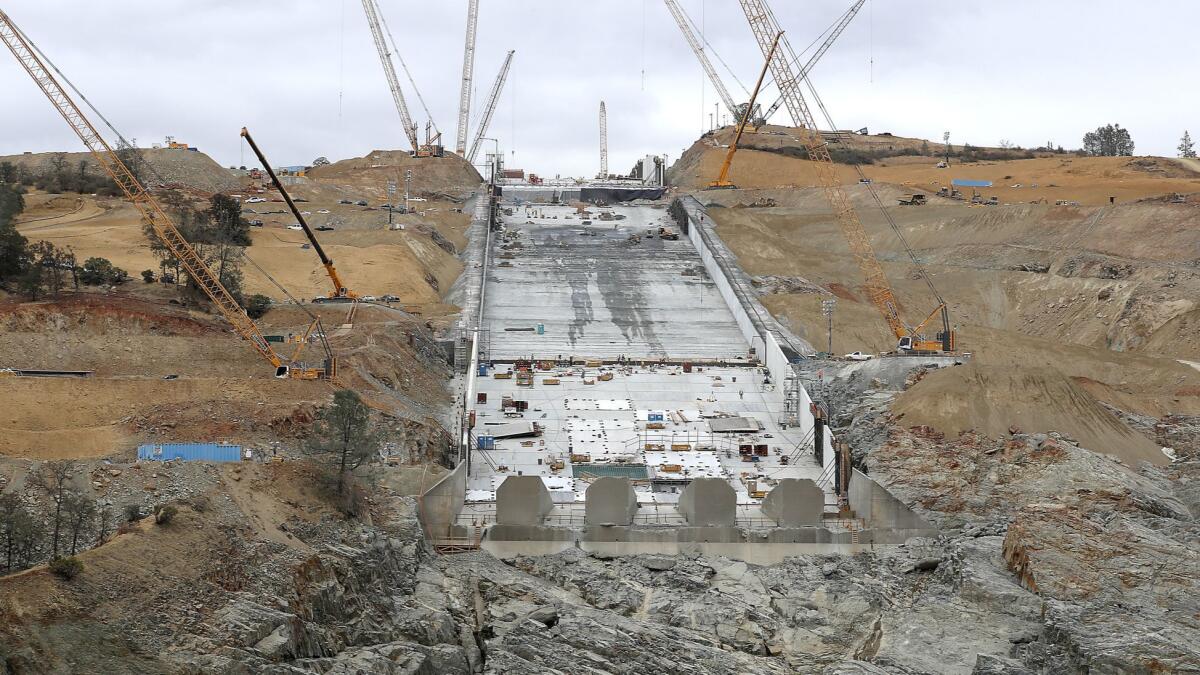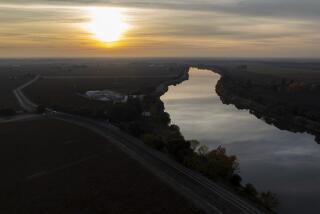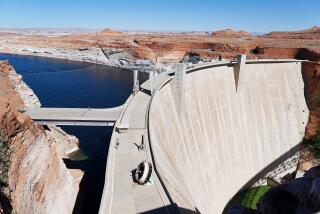Oroville Dam repair costs soar past $1 billion

Fixing the Oroville Dam spillway wrecked by storms in 2017 will cost $1.1 billion — a $455-million hike from initial estimates — the state Department of Water Resources announced Wednesday.
The swelling cost can be blamed on design changes that have been made over the last 16 months and damage to the facility near Oroville, Calif., that was far more extensive than initially presumed, the department said.
The Department of Water Resources designed the repairs and issued a contract to Kiewit Corp. in April 2017 based on an estimate that the company could perform the work for $275 million. But the cost of that portion of the project has shot up to $630 million. In addition, the department’s internal costs have grown by $100 million, reaching $310 million. The agency also paid $160 million in emergency response costs, including removing sediment and installing temporary power lines.
In total, the cost of getting the spillway repaired and upgraded has gone up by about $1 million every day since April 2017.
The Federal Emergency Management Agency is supposed to pay for 75% of the repair costs, leaving the other 25% to agencies in the State Water Project. That would leave customers of water agencies such as the Metropolitan Water District of Southern California, which serves the city of Los Angeles, on the hook for hundreds of millions of dollars. A Metropolitan Water District spokesman referred questions about those costs back to the state Department of Water Resources.
The biggest cost of the spillway failure could be legal claims from affected residents and businesses that have been mounting against the Department of Water Resources, seeking billions of dollars in damages allegedly caused by the agency’s management of the dam and the near-catastrophe at the facility.
After a series of powerful storms in February 2017 slammed the Feather River watershed, the lake behind the Oroville Dam filled up and forced operators to open the gates to the 3,000-foot-long spillway — sending down more water at freeway speeds than flows on average over Niagara Falls.
The spillway began breaking apart when releases hit 55,000 cubic feet of water per second, a small fraction of its designed capacity. That triggered an evacuation of 188,000 residents who lived downstream.
An independent investigation found that the 1960s-era spillway had numerous defects, such as thin concrete, poor anchors to the underlying rock and a weak rock base. It allowed the rushing water to lift the concrete sections and scour the underlying foundation. One of the craters left by the water was 80 feet deep.
The report also found that human error contributed to the operational and maintenance problems that preceded the emergency.
The new spillway will have concrete slabs thicker than an airport runway, reinforcement rods and thousands of anchors epoxied at least 15 feet deep into rock — all intended to make it significantly stronger than the original design.
Department of Water Resources spokeswoman Erin Mellon said the Kiewitt contract was issued when only 30% of the design work had been completed, based on unknown geology and unknown amounts of materials that would be needed. The forensic engineering investigation into the causes of the accident was still incomplete, and the repairs had to move at emergency speed to protect public safety, she said.
Mellon said the $1.1-billion cost is still subject to change, meaning more increases could be coming. The original contract, she said, did not contain a contingency that construction agreements often have to cover unexpected cost increases.
The original spillway cost $13.7 million when completed in 1968, which would be about $101 million adjusted for inflation to 2018 dollars. That means the repairs are on pace to cost 10 times more than the construction itself.
Robert Bea, a retired UC Berkeley civil engineer and member of the National Academy of Engineering, said such repairs to a heavy structure can easily surpass the cost of building a new one. Tons of debris had to be removed from the hillside and riverbed, the work had to be performed in stages, and the new spillway will be significantly stronger than the original.
Even after the spillway fixes are completed, the dam’s gate structures will remain seriously compromised, posing up to another $1 billion in repairs, Bea said.
Apart from fixing the dam, the state is also facing billions of dollars in legal claims by residents and businesses who were evacuated.
A lawsuit filed on behalf of 42 individuals, businesses and farms by the law firm of Cotchett, Pitre & McCarthy seeks millions of dollars in damages from mismanagement and defects in the Oroville Dam. The firm has another suit representing the city of Oroville as well as one seeking class-action status, said Eric J. Buescher, an attorney at the firm.
Buescher said downriver property owners have suffered a loss of property value because they are now vulnerable to a dam that has decades of deferred maintenance. “The fact that the state has a $1-billion repair to the spillway reflects years of deferred maintenance,” he said.
Butte County Dist. Atty. Michael Ramsey has filed suit against the state seeking tens of billions of dollars for damage caused by debris that was sent into the Feather River when the spillway broke up.
Twitter: @rvartabedian
More to Read
Sign up for Essential California
The most important California stories and recommendations in your inbox every morning.
You may occasionally receive promotional content from the Los Angeles Times.










